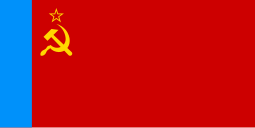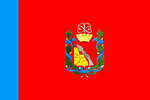
The State Flag of the Union of Soviet Socialist Republics, or simply the Soviet flag, was a red banner with two communist symbols displayed in the canton: a gold hammer and sickle topped off by a red five-point star bordered in gold. The flag's design and symbolism are derived from several sources, but emerged during the Russian Revolution. It has also come to serve as the standard symbol representing communism as a whole, recognized as such in international circles, even after the dissolution of the Soviet Union in 1991.

The national flag of the Russian Federation is a tricolour of three equal horizontal fields: white on the top, blue in the middle, and red on the bottom. It was first raised in 1696, as an ensign for merchant ships under the Tsardom of Russia.
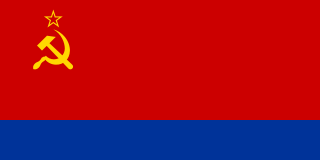
The flag of the Azerbaijan Soviet Socialist Republic was a plain red flag with a golden hammer and sickle and a gold-bordered red star in its upper canton and an horizontal dark blue band on the bottom fourth, representing the Caspian Sea.
The flags of the Soviet Socialist Republics were all defaced versions of the flag of the Soviet Union, which featured a golden hammer and sickle and a gold-bordered red star on a red field.

When the Soviet Union existed, different governments had ruled the southern Caucasus regions of Chechnya and Ingushetia. Within the Mountain Autonomous Socialist Soviet Republic, later annexed into the Russian Socialist Federative Soviet Republic, they were known as the Chechen Autonomous Oblast and the Ingush Autonomous Oblast, which were unified on January 15, 1934 to form the Checheno-Ingush Autonomous Oblast. It was elevated to an autonomous republic as the Checheno-Ingush Autonomous Soviet Socialist Republic from 1936 to 1944 and again from 1957 to 1993. Its capital was Grozny.

The Flag of Udmurtia is one of the official state symbols of Udmurtia. The proportion of width and length of the flag is 1:2. It is a rectangular three-color cloth consisting of vertical equal stripes of black, white and red with an eight-pointed red cross. The black colour in the flag is a symbol of the earth and stability, red means the sun and life and white means a space and moral purity. The designer of the flag of the Udmurt Republic was Yuri Lobanov. The appropriate law N26-РЗ "On the National Flag of the Udmurt Republic" appeared on April 30, 2002.

The flag of Crimea is the flag of the Autonomous Republic of Crimea in Ukraine and the Republic of Crimea controlled by Russia. The flag was officially adopted on 24 September 1992 as the flag of the Republic of Crimea, readopted on 21 April 1999, then readopted on 4 June 2014 as the flag of the Republic of Crimea, annexed by the Russian Federation.

The Russian Soviet Federative Socialist Republic, previously known as the Russian Soviet Republic and the Russian Socialist Federative Soviet Republic, as well as being unofficially referred to as Soviet Russia, the Russian Federation, or simply Russia, was an independent federal socialist state from 1917 to 1922, and afterwards the largest and most populous constituent republic of the Soviet Union (USSR) from 1922 to 1991, until becoming a sovereign part of the Soviet Union with priority of Russian laws over Union-level legislation in 1990 and 1991, the last two years of the existence of the USSR. The Russian SFSR was composed of sixteen smaller constituent units of autonomous republics, five autonomous oblasts, ten autonomous okrugs, six krais and forty oblasts. Russians formed the largest ethnic group. The capital of the Russian SFSR and the USSR as a whole was Moscow and the other major urban centers included Leningrad, Stalingrad, Novosibirsk, Sverdlovsk, Gorky and Kuybyshev. It was the first socialist state in the world.

The emblem of the Russian Soviet Federative Socialist Republic (RSFSR) was adopted on 10 July 1918 by the government of the Russian Soviet Federative Socialist Republic, and modified several times afterwards. It shows wheat as the symbol of agriculture, a rising sun for the future of the Russian nation, the red star as well as the hammer and sickle for the victory of communism and the "world-wide socialist community of states".
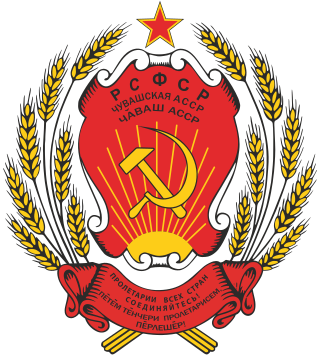
The national emblem of the Chuvash Autonomous Soviet Socialist Republic was adopted in 1937 by the government of the Chuvash Autonomous Soviet Socialist Republic. The emblem is identical to the emblem of the Russian Soviet Federative Socialist Republic.
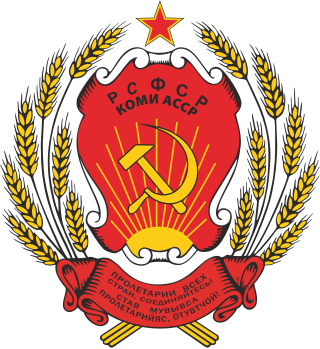
The emblem of the Komi Autonomous Soviet Socialist Republic was adopted in 1938 by the government of the Komi Autonomous Soviet Socialist Republic. The emblem is identical to the emblem of the Russian Soviet Federative Socialist Republic.
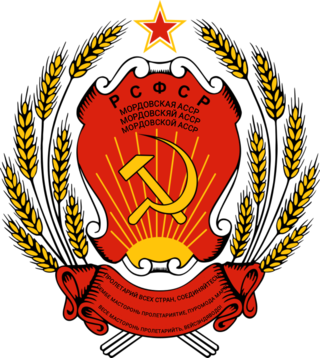
The national emblem of the Mordovian Autonomous Soviet Socialist Republic was adopted in 1937 by the government of the Mordovian Autonomous Soviet Socialist Republic. The emblem is identical to the emblem of the Russian Soviet Federative Socialist Republic.
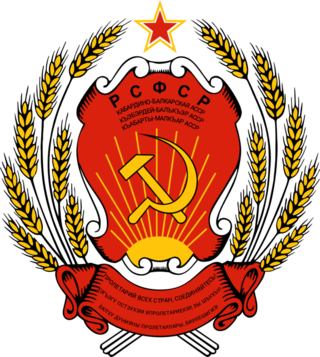
The national emblem of the Kabardino-Balkarian Autonomous Soviet Socialist Republic was adopted in 1937 by the government of the Kabardino-Balkarian Autonomous Soviet Socialist Republic. The emblem is identical to the emblem of the Russian Soviet Federative Socialist Republic.

The flag the Chuvash Autonomous Soviet Socialist Republic was adopted in 1954 by the government of the Chuvash Autonomous Soviet Socialist Republic. The flag is identical to the flag of the Russian Soviet Federative Socialist Republic.

The flag the Mari Autonomous Soviet Socialist Republic was adopted in 1954 by the government of the Mari Autonomous Soviet Socialist Republic. The flag is identical to the flag of the Russian Soviet Federative Socialist Republic.

The flag the Yakut Autonomous Soviet Socialist Republic was adopted in 1954 by the government of the Yakut Autonomous Soviet Socialist Republic. The flag is identical to the flag of the Russian Soviet Federative Socialist Republic.

The flag of the Kabardino-Balkarian Autonomous Soviet Socialist Republic was adopted in 1957 by the government of the Kabardino-Balkarian Autonomous Soviet Socialist Republic. The flag is identical to the flag of the Russian Soviet Federative Socialist Republic.

The flag of the Komi Autonomous Soviet Socialist Republic was adopted in 1954 by the government of the Komi Autonomous Soviet Socialist Republic. The flag is identical to the flag of the Russian Soviet Federative Socialist Republic.

The flag of the North Ossetian Autonomous Soviet Socialist Republic was adopted in 1954 by the government of the North Ossetian Autonomous Soviet Socialist Republic. The flag is identical to the flag of the Russian Soviet Federative Socialist Republic.

The flag of the Udmurt Autonomous Soviet Socialist Republic was adopted in 1954 by the government of the Udmurt Autonomous Soviet Socialist Republic. The flag is identical to the flag of the Russian Soviet Federative Socialist Republic.
 Early variant of the flag of the Russian SFSR, approved on 10 July 1918 [1]
Early variant of the flag of the Russian SFSR, approved on 10 July 1918 [1] 